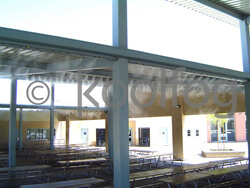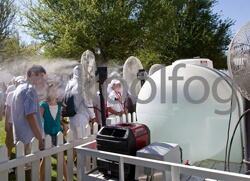Heat stress related deaths on the football field have been popping up all over the media landscape lately and with good reason. From 2005-2009 there have been 18 heat related preventable deaths across the nation, all but one being high school aged children. According to the University of Connecticut’s Korey Stringer Institute (a non-profit group created by Kelci Stringer after her husband’s heat stroke induced death while playing for the Minnesota Vikings as a lineman in 2001), that’s more deaths in 5 years than any other 5 year block in the past 35 years. In places like Georgia, preseason heat acclimation guidelines have been put into place in order to give untrained coaches the measurement tools, resources and guidelines so that these completely preventable deaths do not have to be in vain. These new guidelines clearly outline specific heat acclimation standards that effect practice schedules, break times, the appropriate addition of uniforms during practice and necessary outdoor cooling stations positioned at each practice for the possible emergencies where fast acting cooling is needed as well as regulated temperate areas for resting. They also suggest coaches use a Wet Bulb Globe Temperature Index, which accounts for temperature, humidity and radiation from the wind, sun, etc. and is arguably a more accurate indicator than a simple heat index.
One element of preventing heat stress related deaths is understanding the physiological process itself. There are four main methods of cooling the body down: radiation, evaporation, convection and conduction. The first three are internal processes, the last one being a response process from an external source. 65% of heat is released by radiation but only when the ambient temperature is lower than the body’s skin temperature. In hot dry climates or hot humid climates, these ambient temperatures are almost always high during those beginning months of preseason practice for football players. Using methods of conduction and evaporation mark the next most effective strategies for preventing heat stress related deaths. Evaporative cooling takes place within an active exercise session after ambient temperatures are higher than the skin temperature is. The muscles require more blood to carry the necessary oxygen to the cells. Energy in the form of heat builds up in your muscles and as the heated blood reaches the hypothalamus section of your brain, it tells the skin vessels and capillaries to expand pushing the blood towards the surface to eliminate heat by perspiration. Conduction in the form of ice baths currently used for extreme cooling are usually administered well after any other technique could be effective. Although water is up to 40 times more efficient in lowering temperatures than air, the question begs why use emergency measures when you can create a proactive approach to preventative heat stress related deaths? Is this not the purpose of the guidelines in the first place?
Outdoor cooling stations that employ evaporative cooling can work in perfect conjunction with the new mandatory break schedule and outdoor cooling areas. Misting systems that push thousands of tiny droplets through misting nozzles pull energy from the air in the form of heat and replace it with cooled air. This can cause a 35 degree change in the ambient temperature and you don’t have to be directly under the misters or directly in front of a misting fan to begin to feel the difference. Integrating an effective outdoor cooling station into football program heat stress prevention strategies means the 58 high school football players that have died between 1980 and 2009 will have added purpose and thought to the turbulent landscape of high school sports.
- Choosing the Best Misting Lines and Nozzles for your System - September 5, 2017
- Mesmerizing Fountain Fog Effects - August 28, 2017
- Retail Center Misting Makes Summer Shopping a Breeze - August 21, 2017




